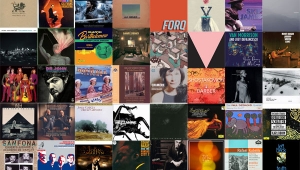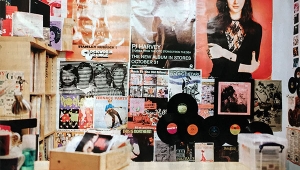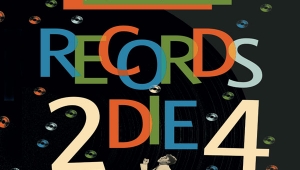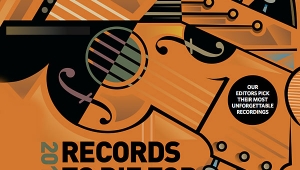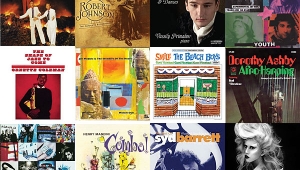| Columns Retired Columns & Blogs |
2000 Records to Die For Page 11
David Sokol
STEVIE WONDER: Songs in the Key of Life
Motown 374 630 340 2 (2 CDs). 1976. Stevie Wonder, prod.; John Fischbach, Gary Olazabal, engs. AAD. TT: 104:42
Staggering as it is, Stevie Wonder was barely 26 when he released this musical monolith, a 21-song exploration that bridged the pop and soul worlds with compassion and spirituality, was the rage in the mid-'70s, and continues to sound utterly fresh today. Although Wonder was already a major star (this was his 16th album, after all), the scope of Songs earned him a spot beside Dylan, Lennon, and McCartney as one of the great songwriters of his time. From "Isn't She Lovely" (a love song to a newborn daughter) to "Sir Duke" (a love song to the great Ellington) to "Black Man" (a love song to human accomplishment) to "Knocks Me Off My Feet" (a just-plain love song), Wonder uses strings, brass, all kinds of percussion, a church choir, his own divine voice, and an army of other instrumentation to paint his masterpiece. One of those rare Gerald Ford/Jimmy Carter-era recordings that still yields new subtleties and joys with every listen, this is one to die for, again and again.
PAM TILLIS: Sweetheart's Dance
Arista 18758-2 (CD). 1994. Pam Tillis, Steve Fishell, prods.; Mike Poole, eng. AAD? TT: 32:52
Country music has become so generic and homogenized lately that it's hard to believe that just five years have passed since Pam Tillis released this gem and was subsequently crowned the Country Music Association's Female Vocalist of the Year. The daughter of Music City journeyman Mel Tillis, Pam grew up within spittin' distance of the Grand Ole Opry, but early in her career discovered how to respectfully take the traditional country that's in her blood and make it thoroughly contemporary. With her sweet, righteous twang, she's untouched in her ability to convey heartbreak, compassion, and good-natured fun, and Sweetheart's Dance bursts with conviction and warmth. Half of its songs were hits, though "I Was Blown Away" had the misfortune of bulleting up the charts at the time of the Oklahoma City bombing, and was voluntarily pulled off the radio. This collection assembles an all-star team of players that, besides guitarist Brent Mason, steel guitarist Paul Franklin, and fiddler Sam Bush, also includes Daddy Bluegrass Bill Monroe in a gorgeous mandolin cameo. All this, plus guest vocals from Kim Richey, Mary Chapin Carpenter, Vince Gill, and Mel himself, make this the best mainstream country album of the 1990s.
HERBIE NICHOLS: The Complete Blue Note Recordings
Herbie Nichols, piano; Al McKibbon, Teddy Kotick, bass; Art Blakey, Max Roach, drums
Blue Note CDP 8 59352 2 (3 mono CDs). 1997. Alfred Lion, prod.; Rudy Van Gelder, eng. AAD. TT: 3:32:43
"Herbie Nichols was my hero," Cecil Taylor said to me of this jazz original, and it's more than likely that Nichols would have found his audience, much as Taylor did. But leukemia claimed this gentle giant at the age of 44, in April 1963. Nichols was a bridge between Jelly Roll Morton, Teddy Wilson, Art Tatum, Mary Lou Williams, Thelonious Monk, Elmo Hope, and Bud Powell on one hand, and Mal Waldron, Herbie Hancock, Andrew Hill, Hasaan Ibn Ali, Cecil Taylor, and Gerri Allen on the other. With deep roots in New Orleans, Harlem stride, and the European concert tradition, Nichols' music also reflects a profoundly African rhythmic aesthetic. His melodies derive directly from complex root syncopations, and his innate ability to orchestrate rhythm inspires heroic interplay with drummers Blakey and Roach, who treat his songforms like little drum concertos.
JO JONES: The Essential Jo Jones
Jo Jones, drums; Emmett Berry, trumpet; Benny Green, Lawrence Brown, trombone; Rudy Powell, clarinet; Lucky Thompson, tenor sax; Freddie Greene, guitar; Nat Pierce, Count Basie, piano; Ray Bryant, piano; Tommy Bryant, Walter Page, bass
Vanguard 101/2-2 (CD). 1955-58/1995. John Hammond, prod. AAD. TT: 78:30
Jonathan David Samuel Jones' place in jazz history would be sacrosanct and secure if for nothing other than his role as the drummer in the "All-American Rhythm Section" of the great Count Basie Orchestra. On the first of six joyous selections here from a pair of August 1955 sessions, the rhythm team of Jones, guitarist Freddie Greene, and bassist Walter Page is reunited one last time with pianist Count Basie for a rousing rendition of "Shoe Shine Boy." Their collective dynamics, canny blues sensibility, coy minimalism, and telepathic brand of interplay is the very essence of swing, but—as the delirious laughter that greets their witty improvised coda suggests—there is a shared sense of people, places, and things that is peculiar to them alone. Pianist Nat Pierce carries on ably throughout the rest of the session, which reprises the elegance and locomotion of the Basie band with great spirit, particularly in the person of tenor saxophonist Lucky Thompson.
BILL HOLMAN BAND: Brilliant Corners
Bill Holman, arr.; Carl Saunders, Ron Stout, Bob Summers, trumpet; Andy Martin, Bob Enevoldsen, trombone; Lanny Morgan, Pete Christlieb, Bill Perkins, saxes; Rich Eames, piano; Dave Carpenter, bass; Bob Leatherbarrow, drums
JVC XRCD JVCXR-0028 (CD). 1997. Akira Taguchi, prod.; Allen Sides, eng. DDD. TT: 69:09
The title track, "Rhythm-A-Ning," "Straight, No Chaser," and others—all crackle with Bill Holman's unique genius. He takes someone as strong as Monk and makes the music his own. But when all's done, I keep coming back to "Bemsha Swing." Max Roach played trap drums and timpani on Monk's 1956 Riverside original; here, Holman keeps that low-end drum thump via Bob Leatherbarrow's crisp, fat whaps, but inserts an ear-catching device: a quasi-New Orleans second-line wobble, an infectious beat that drives this piece through the roof. The number keeps building as pianist Rich Eames, trumpeter Bob Summers, and altoist Bill Perkins let loose, then comes the killer: a shout chorus with screaming trumpets that is, absolutely, to die for. This XRCD remastering has a wide soundstage filled with massive orchestral sounds that never muddy, in which soloists can always be heard and where you are definitely square in the middle.
DUKE ELLINGTON: Togo Brava Suite
Duke Ellington, piano; Cootie Williams, Johnny Coles, Mercer Ellington, trumpet; Chuck Connors, Booty Wood, trombone; Russell Procope, Paul Gonsalves, Harold Ashby, Harold Minerve, Norris Turney, saxes, flutes; Joe Benjamin, bass; Rufus Jones, drums
Blue Note 8 30082 2 (CD). 1971. Noel Walker, prod., eng. AAD. TT: 67:04
This minor masterpiece was recorded live in England in 1971 and features some ace Ducal comrades. Tenorman Gonsalves charges through "Cottontail," adds a gritty cadenza, then slows way down for the ethereal, crying-toned "Happy Reunion." Trumpeter Williams emits his trademark growl on "C Jam Blues," Ashby offers big-toned tenor on the four-part title track, and Norris Turney's flute has bright moments there as well. The maestro puts the piano up front on the succulently lyrical "Lotus Blossom," a paean to his departed alter ego, Billy Strayhorn. Then there's "Addi," the cut that got to me years ago, and did it again this morning. This simple minor blues showcases the unheralded but magnificent altoist "Geezil" Minerve, who delivers ripe, almost bursting notes and right-on-the-money ideas that make my head spin, my heart thump, and always leave me stone cold on the floor. The CD sounds extraordinarily clear and rich for a live recording, with a front-row soundstage and impressive detail.
STEVIE WONDER: Songs in the Key of Life
Motown 374 630 340 2 (2 CDs). 1976. Stevie Wonder, prod.; John Fischbach, Gary Olazabal, engs. AAD. TT: 104:42
Staggering as it is, Stevie Wonder was barely 26 when he released this musical monolith, a 21-song exploration that bridged the pop and soul worlds with compassion and spirituality, was the rage in the mid-'70s, and continues to sound utterly fresh today. Although Wonder was already a major star (this was his 16th album, after all), the scope of Songs earned him a spot beside Dylan, Lennon, and McCartney as one of the great songwriters of his time. From "Isn't She Lovely" (a love song to a newborn daughter) to "Sir Duke" (a love song to the great Ellington) to "Black Man" (a love song to human accomplishment) to "Knocks Me Off My Feet" (a just-plain love song), Wonder uses strings, brass, all kinds of percussion, a church choir, his own divine voice, and an army of other instrumentation to paint his masterpiece. One of those rare Gerald Ford/Jimmy Carter-era recordings that still yields new subtleties and joys with every listen, this is one to die for, again and again.
PAM TILLIS: Sweetheart's Dance
Arista 18758-2 (CD). 1994. Pam Tillis, Steve Fishell, prods.; Mike Poole, eng. AAD? TT: 32:52
Country music has become so generic and homogenized lately that it's hard to believe that just five years have passed since Pam Tillis released this gem and was subsequently crowned the Country Music Association's Female Vocalist of the Year. The daughter of Music City journeyman Mel Tillis, Pam grew up within spittin' distance of the Grand Ole Opry, but early in her career discovered how to respectfully take the traditional country that's in her blood and make it thoroughly contemporary. With her sweet, righteous twang, she's untouched in her ability to convey heartbreak, compassion, and good-natured fun, and Sweetheart's Dance bursts with conviction and warmth. Half of its songs were hits, though "I Was Blown Away" had the misfortune of bulleting up the charts at the time of the Oklahoma City bombing, and was voluntarily pulled off the radio. This collection assembles an all-star team of players that, besides guitarist Brent Mason, steel guitarist Paul Franklin, and fiddler Sam Bush, also includes Daddy Bluegrass Bill Monroe in a gorgeous mandolin cameo. All this, plus guest vocals from Kim Richey, Mary Chapin Carpenter, Vince Gill, and Mel himself, make this the best mainstream country album of the 1990s.
![]()
Chip Stern
HERBIE NICHOLS: The Complete Blue Note Recordings
Herbie Nichols, piano; Al McKibbon, Teddy Kotick, bass; Art Blakey, Max Roach, drums
Blue Note CDP 8 59352 2 (3 mono CDs). 1997. Alfred Lion, prod.; Rudy Van Gelder, eng. AAD. TT: 3:32:43
"Herbie Nichols was my hero," Cecil Taylor said to me of this jazz original, and it's more than likely that Nichols would have found his audience, much as Taylor did. But leukemia claimed this gentle giant at the age of 44, in April 1963. Nichols was a bridge between Jelly Roll Morton, Teddy Wilson, Art Tatum, Mary Lou Williams, Thelonious Monk, Elmo Hope, and Bud Powell on one hand, and Mal Waldron, Herbie Hancock, Andrew Hill, Hasaan Ibn Ali, Cecil Taylor, and Gerri Allen on the other. With deep roots in New Orleans, Harlem stride, and the European concert tradition, Nichols' music also reflects a profoundly African rhythmic aesthetic. His melodies derive directly from complex root syncopations, and his innate ability to orchestrate rhythm inspires heroic interplay with drummers Blakey and Roach, who treat his songforms like little drum concertos.
Rather than run changes, Nichols always deconstructed and recast his thematic ideas in a loping, two-handed orchestral style. His improvisations are aglow with edgy, elliptical harmonies, depicting a dissonant, asymmetrical brand of counterpoint and an oblique melodic focus. His left-hand punctuations inevitably find the cracks in time—it's like watching mercury float. What's more, like Monk's, Nichols' tempos—whether on a medium stroll such as "Lady Sings the Blues" or a minor gallop like "Riff Primitiff"—are as distinctive a stylistic signature as are his angular harmonies and melodies. The overall effect of these excellent recordings from 1955-56 is darkly romantic and hypnotically swinging—it seems as if Nichols could keep extending and elongating his melodic elisions for eternity.
JO JONES: The Essential Jo Jones
Jo Jones, drums; Emmett Berry, trumpet; Benny Green, Lawrence Brown, trombone; Rudy Powell, clarinet; Lucky Thompson, tenor sax; Freddie Greene, guitar; Nat Pierce, Count Basie, piano; Ray Bryant, piano; Tommy Bryant, Walter Page, bass
Vanguard 101/2-2 (CD). 1955-58/1995. John Hammond, prod. AAD. TT: 78:30
Jonathan David Samuel Jones' place in jazz history would be sacrosanct and secure if for nothing other than his role as the drummer in the "All-American Rhythm Section" of the great Count Basie Orchestra. On the first of six joyous selections here from a pair of August 1955 sessions, the rhythm team of Jones, guitarist Freddie Greene, and bassist Walter Page is reunited one last time with pianist Count Basie for a rousing rendition of "Shoe Shine Boy." Their collective dynamics, canny blues sensibility, coy minimalism, and telepathic brand of interplay is the very essence of swing, but—as the delirious laughter that greets their witty improvised coda suggests—there is a shared sense of people, places, and things that is peculiar to them alone. Pianist Nat Pierce carries on ably throughout the rest of the session, which reprises the elegance and locomotion of the Basie band with great spirit, particularly in the person of tenor saxophonist Lucky Thompson.
But it's the second session, a piano-trio date from April 1958, that is altogether timeless and remarkable. Philadelphia brothers Tommy and Ray Bryant, on bass and pianos, respectively, prove the perfect foils for Jo Jones' graceful, commanding melodic gestures and orchestral percussive scope. Jones' impeccable rhythmic intuitions and cultivated senses of tune, timbre, tempo, and touch are unequaled, if one is to judge by his subliminal groove on the agonizingly slow "Spider Kelly's Blues," or his Picasso-like brushwork on the fiery tempos of "Bicycle for Two." Of course, you'd be inspired too if you were playing with the great Ray Bryant, a pianist of formidable technical gifts possessed of seemingly endless reserves of down-home blues and sanctified soul—and a superb composer to boot, as witnessed by the joyous Afro-Cuban changes of "Cubano Chant" and the driving rhythm changes of "Splittin.' " But for all their collective elegance and mentholated swing, the pièce de résistance has to be the sustained invention and grandeur of Jones' feature on "Old Man River," perhaps the greatest recorded drum solo in the history of jazz—a storytelling marvel of epic proportions. To hear is to peep why all the drummers in the know call him Papa Jo.
![]()
Zan Stewart
BILL HOLMAN BAND: Brilliant Corners
Bill Holman, arr.; Carl Saunders, Ron Stout, Bob Summers, trumpet; Andy Martin, Bob Enevoldsen, trombone; Lanny Morgan, Pete Christlieb, Bill Perkins, saxes; Rich Eames, piano; Dave Carpenter, bass; Bob Leatherbarrow, drums
JVC XRCD JVCXR-0028 (CD). 1997. Akira Taguchi, prod.; Allen Sides, eng. DDD. TT: 69:09
The title track, "Rhythm-A-Ning," "Straight, No Chaser," and others—all crackle with Bill Holman's unique genius. He takes someone as strong as Monk and makes the music his own. But when all's done, I keep coming back to "Bemsha Swing." Max Roach played trap drums and timpani on Monk's 1956 Riverside original; here, Holman keeps that low-end drum thump via Bob Leatherbarrow's crisp, fat whaps, but inserts an ear-catching device: a quasi-New Orleans second-line wobble, an infectious beat that drives this piece through the roof. The number keeps building as pianist Rich Eames, trumpeter Bob Summers, and altoist Bill Perkins let loose, then comes the killer: a shout chorus with screaming trumpets that is, absolutely, to die for. This XRCD remastering has a wide soundstage filled with massive orchestral sounds that never muddy, in which soloists can always be heard and where you are definitely square in the middle.
DUKE ELLINGTON: Togo Brava Suite
Duke Ellington, piano; Cootie Williams, Johnny Coles, Mercer Ellington, trumpet; Chuck Connors, Booty Wood, trombone; Russell Procope, Paul Gonsalves, Harold Ashby, Harold Minerve, Norris Turney, saxes, flutes; Joe Benjamin, bass; Rufus Jones, drums
Blue Note 8 30082 2 (CD). 1971. Noel Walker, prod., eng. AAD. TT: 67:04
This minor masterpiece was recorded live in England in 1971 and features some ace Ducal comrades. Tenorman Gonsalves charges through "Cottontail," adds a gritty cadenza, then slows way down for the ethereal, crying-toned "Happy Reunion." Trumpeter Williams emits his trademark growl on "C Jam Blues," Ashby offers big-toned tenor on the four-part title track, and Norris Turney's flute has bright moments there as well. The maestro puts the piano up front on the succulently lyrical "Lotus Blossom," a paean to his departed alter ego, Billy Strayhorn. Then there's "Addi," the cut that got to me years ago, and did it again this morning. This simple minor blues showcases the unheralded but magnificent altoist "Geezil" Minerve, who delivers ripe, almost bursting notes and right-on-the-money ideas that make my head spin, my heart thump, and always leave me stone cold on the floor. The CD sounds extraordinarily clear and rich for a live recording, with a front-row soundstage and impressive detail.
- Log in or register to post comments





